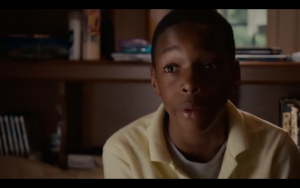We can see the worry and hope on parents and students faces as they eagerly wait for their number to be called during the lottery to get into a charter school. In their minds, the parents know that this is the last chance for their children to have a better opportunity at education. The people that are attending the lottery want their children to be in the best school possible that will meet their needs. (Guggenheim1:30.03) They are bound to their neighborhood schools, which do not have a good reputation for a student to succeed academically. Other families attending the lottery are there because they do not what their children to attend the neighborhood public schools and cannot afford private institutions.
With limited spots available in the schools and an overwhelming amount of applicants, by law there has to be a public lottery in place. During the lottery scenes the filmmakers would focus on the student and their loved ones faces to capture the emotions as they call number after number, not hearing their own yet. On the screens in white text we see the amount of spaces available in each school and we are able to see the number decrease as names are being called, and the chances for the children are becoming more slim.(Guggenheim 1:33.00) This is important because we are able to internalize the emotions that the families are feeling.
One student whose story that we follow throughout the movie attended the lottery to obtain a spot at the SEED school. After his number was not called there was a short interview with him, which displayed the defeat that he felt. The reporter asked him “why do you want to go to the SEED school?” and in his reply he stated “I want my kids to have better than what I had. I don’t want them around this stuff”(Guggenheim 1:22.07) This students knew that the SEED school was an opportunity for him to better himself and to have a successful future. The reporter and the student further discuss that his father was not around and that he passed away when he was young from drugs. The student made it very clear that he wanted a better future for himself and he knew that a good education was his ticket to success.
According to The Dirty Dozen by Kevin G. Welner charter schools are supposed to fit the needs of the students in their area. So how do they do so if there are so many kids on their waitlists? As stated by Welner “If charter schools identified as successful are not serving a cross-section of the students population, then where do the students go who are left out?” (Welner) If the charter school are targeting the neighborhood students, and not all of the students are accepted in the lottery then what happens to their education? Welner would respond to this as a technique used by charter schools to enroll the students that they would actually want there. The Dirty Dozen discusses twelve techniques used by charter schools to filter out the students they want attending their schools.
Ferguson, B., & Royal, K. H. (2011). The Deception of the “Lottery” at Lycee Francais
and Audubon Schools: The Misuse of Charter Schools, Part II. New Orleans, LA: http://www.researchonreforms.org/html/documents/DeceptionoftheLottery.pdf
Guggenheim, Davis. Waiting for “Superman.” 2010. Film.
Welner, Kevin G. January 17, 2011“Why ‘Inside Job’ bests ‘Waiting for Superman’ on school reform.” Teachers College Record.


